Nesting Season...is Here!
Did you know most of our backyard birds nest between February and September?
Studies show that when birds have access to feeders they have more successful broods.
By providing food throughout the nesting season you are helping to increase the bird population.
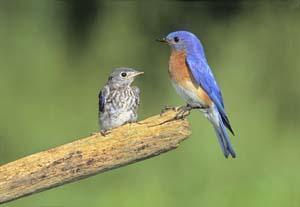
Recent research studies show that birds with access to feeders often lay eggs earlier than those without - and earlier broods typically have higher survival rates than later ones!
Feeders allow breeding females to spend less time searching for food and more time creating higher quality nests. The adults have more time for protecting their nest, eggs, and young from predators.
When abundant food is accessible for parents to provide to their chicks, the extra nutrition can reduce aggression among nest siblings and increases their rate of growth.
As fledglings leave the nest, they are taught to eat from feeders by their parents, a fascinating interaction to observe. Look for the young birds as they follow their parents to the feeder.
Nesting Tips for the Landlord (That's You!)
Watch for robins and mockingbirds to dart in and out of trees and shrubs. This is a sure indicator that their nest is present. Try putting raisins and mealworms on a ground-feeding tray in your yard to entice them to take a snack.
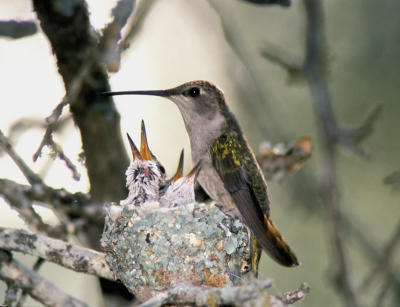 Check your nesting boxes for chickadees, titmice, or wrens raising families. Again, it's fun to place mealworms nearby for the busy parent.
Check your nesting boxes for chickadees, titmice, or wrens raising families. Again, it's fun to place mealworms nearby for the busy parent.
Goldfinches will be increasing their daily intake of seed in preparation for their nesting period starting this month, so watch for great activity on your thistle feeders.
Providing a source of water is by far the best way to draw less common birds to your backyard, especially if there has been a long, hot, dry spell. Run your dripper or mister consistently and you might be able to lure thrushes, warblers, or others.
Summertime is one of the best time to enjoy the fruits of your labor, knowing that you make a difference in the lives of birds!
Monitoring Nest Boxes
One of the most important tasks of being a responsible nest box landlord is to monitor your nest boxes for invasive species.
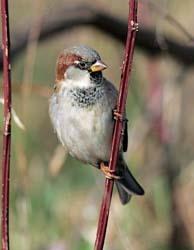 English House Sparrows and European Starlings are not native to North America, but their populations have exploded and they are now two of the most abundant species here. Not only are they crowding out our native birds but they are notorious for breaking open eggs and pecking other birds to death to take over a nesting site.
English House Sparrows and European Starlings are not native to North America, but their populations have exploded and they are now two of the most abundant species here. Not only are they crowding out our native birds but they are notorious for breaking open eggs and pecking other birds to death to take over a nesting site.
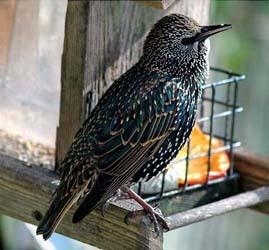 Bluebirds and purple martins nest, for the most part, in man-made birdhouses which are usually erected in areas of human habitation. These habitats are also preferred by the House Sparrow and Starling.
Bluebirds and purple martins nest, for the most part, in man-made birdhouses which are usually erected in areas of human habitation. These habitats are also preferred by the House Sparrow and Starling.
If the sparrows or starlings have built a nest in a nest box or house you should remove the nest and eggs. Be sure you're removing the nest of an English House Sparrow or European Starling. All other native backyard birds are protected by the federal government.
How to Monitor a Nest Box
-
Check the box once a week only on calm, mild, dry days.
-
Limit your viewing time to a minute.
-
Approach the box slowly and lightly tap on the side of the box to give the adult bird a chance to leave.
-
Open the box carefully.
-
Examine the nesting material and any eggs to determine which species are using the box.
-
Dispose of non-native species' nest materials and eggs.
Features of a Good Nest Box
There are many types of nest boxes. Some are simply decorative and do not meet the physical requirements of the birds you want to attract to your yard. We recommend functional boxes, which may also be decorative, but will provide your birds with the following:
-
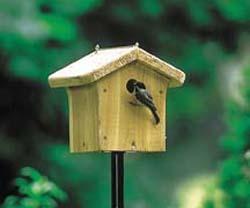 The entry hole must be the right size: large enough for the specific bird to get in, yet small enough to keep other birds out.
The entry hole must be the right size: large enough for the specific bird to get in, yet small enough to keep other birds out. -
The wood should be at least 3/4 of an inch thick to provide insulation.
-
The box does not need additional paints or stains.
-
You should be able to open a panel to monitor nesting activity and clean the box after its use.
-
The roof should be slanted so water can run off easily.
-
Ventilation holes at the top allow the interior to remain cool.
-
Perches on the front of the box are not recommended, as this gives predators an advantage.
-
Each species prefers a nesting box at a particular height above the ground and in the right habitat - see ‘Nesting Chart’
-
Baffles will keep raccoons, squirrels, cats, and other predators out of the box.

